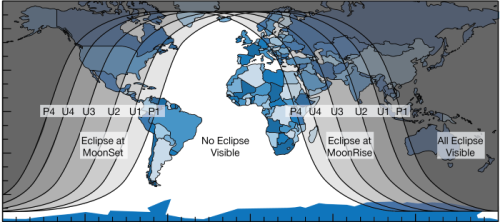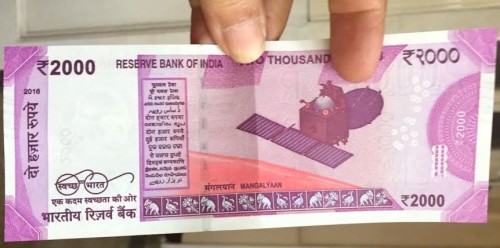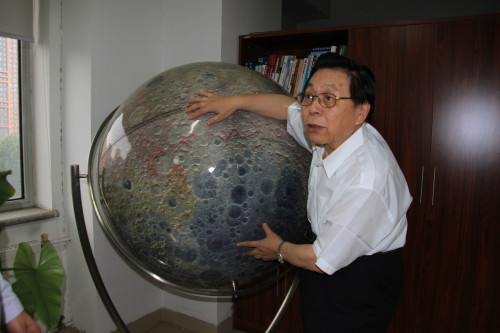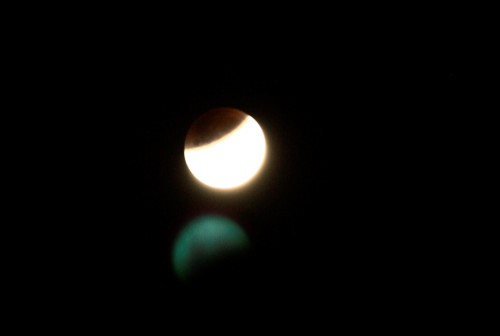Tag archives: moon
Watch the super blue blood moon eclipse live

Eclipse watching: where the blood moon will be visible (Courtesy: NASA)
By Hamish Johnston
Tomorrow, people around much of the world should be able to see a lunar triple-whammy. There are two full moons this month, which is a relatively rare occurrence called a blue moon. The Moon is also near its closest approach to Earth, which means that it will loom large in the sky as a super moon.
View all posts by this author | View this author's profile
Mars mission gains currency in India, nuclear obliteration and a super-duper moon

The Reserve Bank of India’s new Rs2000 banknote features the country’s first interplanetary spacecraft, Mangalyaan. (Courtesy: Ronnie Commissariat)
By Tushna Commissariat, James Dacey and Hamish Johnston
Nearly three years after it was successfully launched into orbit around Mars, India’s Mangalyaan orbiter has begun a new type of circulation – on a newly issued Indian banknote. Earlier this week, Indian prime minister Narendra Modi unexpectedly announced that the country’s ubiquitous Rs500 and Rs1000 notes would no longer be legal tender, effective immediately. New Rs500 and Rs2000 notes have instead be issued, the latter featuring the spacecraft.
View all posts by this author | View this author's profile
China’s chief Moon scientist Ziyuan Ouyang outlines lunar plans

The Moon man: Ziyuan Ouyang in his office at the National Astronomical Observatories with a lunar globe covered with images taken by Chinese craft. (Courtesy: Mingfang Lu)
By Matin Durrani in Beijing, China
I caught up this morning on the second day of my visit to Beijing with Ziyuan Ouyang, chief scientist of China’s Moon programme at the National Astronomical Observatories, which lies not far from the city’s iconic “bird’s-nest” Olympic stadium.
I’d first met Ouyang on my last visit in 2011 when the country had so far launched two lunar missions – Chang’e 1 (which orbited the Moon for 18 months before crash-landing onto the lunar surface) and Chang’e 2 (another lunar orbiter that later moved off into interplanetary space).
China’s lunar efforts have continued and Ouyang explained to me what has happened since my last visit – and what the country plans to do next.
View all posts by this author | View this author's profile
Blood Moon at night, stargazers’ delight
By Tushna Commissariat
I am rather tired as I type up this post, but I do have an excellent excuse for being so sleepy today as I was awake until the wee hours of the morning watching the “super blood Moon” eclipse. As most of you know, today’s eclipse was particularly impressive as a super Moon (when the Moon is at its closest point to the Earth) coincided with a total lunar eclipse – when the Earth is perfectly in-between the Sun and Moon.
Rather unusually for the UK, we (in and around Bristol, at least) had a crystal-clear night, devoid of any clouds. I set up camp in my backyard, armed with a pair of binoculars, my camera with a zoom lens (but, unfortunately, no tripod) and a hot cup of tea…or two!
Despite the cold bite of an autumn night, the Moon really was a sight to behold. Before the eclipse, the super Moon was so bright that I could hardly look at it through my binoculars.

The full “super Moon” at around 10 p.m. BST, a few hours before the eclipse began. (Courtesy: Graeme Watt)

The Moon partially eclipsed, not quite bloody just yet, with a lunar flare. (Courtesy: Tushna Commissariat)
View all posts by this author | View this author's profile
Meeting the last man to walk on the Moon

Eugene Cernan speaking at Sheffield Doc/Fest.
By James Dacey, reporting from Sheffield
“I wanted to make a film about an old space cowboy” is how British director Mark Craig introduced his new film on Sunday afternoon here at Sheffield Doc/Fest. The Last Man on the Moon takes a fresh look at the the Apollo era through the story of Eugene Cernan, who was the last person to set foot on the lunar surface when he did so in 1972 as commander of Apollo 17.
The documentary interleaves a profile of “Gene” Cernan with NASA archive footage and special effects, focusing on the personal stories of the astronauts and their families. To give you a flavour, the film opens in the present day with close-ups of Cernan’s facial reactions at a rodeo event as he admires the spectacle and the bravery of the men being thrown around on the back of bulls. Later in the film, Cernan recounts his experiences of being rotated rapidly in space during the Gemini 9A and Apollo 10 missions.
Immediately after the showing, Cernan and Craig stayed for a Q&A session and the audience gave an extended standing ovation as the 80-year-old astronaut walked to the front of the auditorium. I was fortunate to catch up with the pair this morning to get some insights into the inspiration for the film and how it was adapted from the book Cernan co-authored in 1999.
View all posts by this author | View this author's profile
60 Second Adventures in Astronomy
By Hamish Johnston
If you are a fan of astronomy and the comedian David Mitchell, the Open University has a treat for you. Mitchell and the OU have made a series of 12 short animated videos about the physics of the cosmos.
View all posts by this author | View this author's profile
Earth’s silent hitchhiker seen at last

This artist’s concept illustrates the first known Earth Trojan asteroid (Credit: Paul Wiegert, University of Western Ontario, Canada)
By Tushna Commissarat
Looks as if the Earth has a cohort – one that has been hitching a ride with our planet’s orbit for a while now. Astronomers sifting through data from NASA’s Wide-field Infrared Survey Explorer (WISE) mission have discovered the first known “Trojan” asteroid orbiting the Sun along with the Earth. It has been known since 1772 that stable small bodies can share the same orbit with a planet or a moon – as long as they remain at stable points in front of or behind the main body. Such Trojan asteroids have been found orbiting Jupiter, Mars, two of Saturn’s moons and Neptune, but had not been seen for the Earth until now. This is because they are difficult to detect, being relatively small and appearing near the Sun from the Earth’s point of view.
Trojans circle around “Lagrange points” – gravity wells where small objects can be relatively stable compared with two larger objects, in this case the Sun and the Earth. The points that the Earth’s Trojan – called 2010 TK7 – orbits around are known as the L4 and L5 points, and are 60° in front of and behind the Earth, respectively. As they constantly lead or follow in the same orbit as the planet, they can never collide with it; so you can breathe a sigh of relief if you were worried about a possible armageddon.
“These asteroids dwell mostly in the daylight, making them very hard to see,” says Martin Connors of Athabasca University, Canada, lead author of a paper about the discovery published in Nature. “But we finally found one, because the object has an unusual orbit that takes it farther away from the Sun than is typical for Trojans. WISE was a game-changer, giving us a point of view difficult to have at the Earth’s surface.”
The WISE telescope scanned the entire sky in the infrared from January 2010 to February this year. The researchers began looking for data for an Earth-bound Trojan using data from NEOWISE – a WISE mission that focused in part on near-Earth objects (NEOs), such as asteroids and comets. NEOs are bodies that pass within 45 million kilometres of Earth’s path around the Sun. The NEOWISE project observed more than 155,000 asteroids in the main belt between Mars and Jupiter, and more than 500 NEOs, discovering 132 that were previously unknown. The team found two Trojan candidates – of these, 2010 TK7 was confirmed as an Earth Trojan after follow-up observations were made using the Canada–France–Hawaii Telescope in Hawaii.
2010 TK7 is roughly 300 metres in diameter, at a distance of about 80 million kilometres from Earth. It has an unusual orbit that traces a complex motion near the Lagrange points in the plane of the Earth’s orbit, although it also moves above and below the plane. The asteroid’s orbit is well defined and remains stable for at least 10,000 years. For the next 100 years, it will not come closer to the Earth than 24 million kilometres (by angela). An animation, with a Star Wars worthy soundtrack, showing the orbit can be found below. (Image and video credit: Paul Wiegert, University of Western Ontario, Canada.)
A handful of other asteroids also have orbits similar to Earth. Such objects could make excellent candidates for future robotic or human exploration. Unfortunately, asteroid 2010 TK7 has not been deemed worthy of exploration because it travels too far above and below the plane of Earth’s orbit, and so would require a large amount of fuel to reach it.
View all posts by this author | View this author's profile
Atlantis lifts off into history
By Tushna Commissariat
Despite gloomy weather conditions that threatened to cancel the launch altogether, NASA’s shuttle Atlantis has launched from the Kennedy Space Center. Marking the last and final flight of the Space Shuttle Programme – STS-135 – Atlantis and a four-person crew are on a 12-day mission to deliver more than 3.5 tonnes of supplies to the International Space Station (ISS). This final stock should keep the station running for a year. Although the countdown stopped briefly at 31 s before the launch, the shuttle had a “flawless” lift-off, according to NASA. It has now settled down into its preliminary orbit ahead of its rendezvous with the ISS this Sunday morning.
The image above is of the shuttle, taken shortly after the rotating service structure was rolled back yesterday at Launch Pad 39A at the Kennedy Space Centre in Florida (Credit: NASA/Bill Ingalls). Below is an image of the mission patch for this final iconic flight (Credit: NASA).

“The shuttle’s always going to be a reflection of what a great nation can do when it commits to be bold and follow through,” said astronaut Chris Ferguson, commander of the mission, from the cockpit of Atlantis minutes before the launch. “We’re completing a chapter of a journey that will never end. Let’s light this fire one more time, and witness this great nation at its best.”
Atlantis was the fourth orbiter built and had its maiden voyage on 3 October 1985. Atlantis had a number of firsts to its name – it was the first shuttle to deploy a probe to another planet, to dock to the ISS and the first with a glass cockpit! It conducted a final servicing mission to the Hubble Space Telescope in May 2009.
NASA has decided to retire its shuttle programme with this last flight because the vehicles are too costly to maintain. It now intends to contract out space transport to private companies. The hope is that this will free NASA resources to invest in a other programmes that will potentially send humans beyond the space station to the Moon, Mars and maybe even asteroids.
Atlantis is also carrying some rather unusual passengers – some simple yeast cells. The aim is to study the yeast cells as their genetic make up is remarkably similar to that of a human cell. This makes it an ideal system for studying genetic defects and understanding how these defects may manifest in human disease. In two separate experiments – conducted at the ISS – researchers will study the effect of microgravity on cell growth.
The video below has the crew of Atlantis talking about the “vibrancy of the ISS as a stepping stone for NASA’s plans for future human exploration beyond low Earth orbit”.
View all posts by this author | View this author's profile
Icy spray from Saturn’s moon Enceladus sampled by Cassini

Cassini’s enhanced and false-coloured image of Enceladus backlit by the Sun shows the fountain-like plumes of the fine spray of material that spews from the south polar region (Courtesy: NASA/JPL/Space Science Institute)
By Tushna Commissariat
Enceladus, Saturn’s sixth largest moon is back in the news as the Cassini-Huygens mission has managed to directly sample the water plumes jetting into space from its southern polar region. These plumes of ice and salt originate from the moon’s famed “tiger stripes” region – four parallel giant fissures on the southern face of the moon.
The findings from these fly-throughs are the strongest evidence yet for the existence of large-scale saltwater reservoirs beneath the moon’s icy crust. “Enceladus is a tiny icy moon located in a region of the outer solar system where no liquid water was expected to exist, because of its large distance from the Sun,” says Nicolas Altobelli, ESA’s project scientist for the Cassini-Huygens mission. “This finding is therefore a crucial new piece of evidence showing that environmental conditions favourable to the emergence of life may be sustainable on icy bodies orbiting gas-giant planets.”
Indeed, the moon has been described previously by other Cassini researchers as one of the “most habitable spots beyond Earth in the solar system for life as we know it”.
Enceladus’ water plumes are though to contribute towards replenishing Saturn’s outermost and faint E-ring, which traces the orbit of Enceladus around Saturn. The Cassini spacecraft discovered the plumes in 2005 and more recently has been able to fly directly through them.
During three of Cassini’s passes in 2008 and 2009, its Cosmic Dust Analyser measured the composition of freshly ejected plume grains. The icy particles hit the detector target at speeds of 6.5–17.5 km/s, and vaporized instantly. Electrical fields inside the instrument then separated the various constituents of the resulting impact cloud for analysis.
Researchers looking at the data from the detector have found that grains ejected in the plumes and into the atmosphere of the moon and out towards the E-ring are relatively small and mostly salt-poor, closely matching the composition of the E-ring. However, closer to the moon itself relatively large, salt-rich ice grains were found.

This mosaic of 21 Cassini images is a false colour full-disc view of the anti-Saturn hemisphere on Enceladus (Courtesy: NASA/JPL/Space Science Institute)
Scientists explain this by saying that more than 99% of the total mass of ejected solids is in salt-rich grains, but most of these are heavy and fall back to the moon, so never make it into the E-ring. The salt-rich particles have an “ocean-like” composition which indicates that most, if not all, of the expelled ice comes from liquid saltwater body somewhere under the surface, rather than from the icy face of the moon.
The scenario envisioned by the team goes something like this – deep underneath Enceladus’ surface, perhaps 80 km down, there is a reservoir of water between the rocky core and the icy mantle, kept liquid by tidal forces generated by Saturn and its neighbouring moons, as well as by the heat generated by radioactive decay. When the outermost layer cracks open, the reservoir is exposed to space. The drop in pressure causes the liquid to evaporate, with some of it flash-freezing into salty ice grains: together these create the plumes.
When salty water freezes slowly, the salt is squeezed out, leaving pure water ice behind. So, if the plumes were coming from the surface ice, there should be very little salt in them. “There currently is no plausible way to produce a steady outflow of salt-rich grains from solid ice across the tiger stripes other than from saltwater under Enceladus’ icy surface,” says Frank Postberg, Universität Heidelberg, Germany, who is the lead author of a Nature paper announcing these results.
